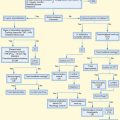132 Lightning and Electrical Injuries
• In high-voltage electrical injuries, the internal damage that the victim has suffered can be significantly greater than the external damage or surface injury indicates.
• Fixed, dilated pupils are not a reliable indicator of brain death in the victim of a lightning strike.
• Oral burns in children can represent electrical injury from chewing on electrical wires.
• Victims in cardiac arrest may respond quite well to defibrillation, so these patients should receive highest priority for treatment at the scene.
• Victims of electrical injuries who have any symptoms are at high risk for compartment syndrome.
• Blunt trauma can occur in up to one third of victims of lightning or high-voltage electrical injuries.
Epidemiology
A strike of lightning is one of the most common environmental causes of sudden cardiac death and is responsible for between 50 and 300 deaths annually in the United States.1,2 Cloud-to-ground lighting strikes, the most destructive form of lightning, occur approximately 30 million times each year,3 most often in Florida and along the southeastern coast of the Gulf of Mexico.4 Lightning has struck more than 10 miles away from the rain of a thunderstorm, so the danger may not always be obvious or apparent.3 Electrical injuries can be equally devastating. The spectrum of injuries from both can range dramatically from minor, localized injuries to death.
Although lightning injury may be one of the most common injuries caused by natural phenomena, its incidence has not been tracked accurately. The incidence is higher in males and in people between 20 and 44 years of age, three of every four occurred in the South or Midwest, and one in four was work related.5 Sport-, wilderness-, and travel-related activities also place people at higher risk for lightning injuries.
Electrical injuries tend to occur in patients in three distinct age groups. The first group is toddlers who encounter household electrical sockets, cords, and appliances. The second is adolescents who engage in risky behavior. The third group comprises adults who work with electricity. Electrical burns account for between 3% and 7% of admissions to burn centers in the United States each year, many of which are occupational injuries. The annual occupational death rate from electrocution is 1 per 100,000; this type of death occurs more frequently in utility workers, miners, and construction workers.6
Pathophysiology
Definitions that should be familiar to those caring for patients with electrical injuries are listed in Box 132.1. Electrical current is the movement of electrical charge from one location to another. Current strength is expressed in amperes. Materials that allow electrical current to flow easily (low resistance) are referred to as conductors. Materials that do not allow flow of electrical current are called insulators.
Box 132.1 Definitions of Electrical Injuries
Alternating current (AC): Electrical source with changing direction of current flow
Current: Flow of electrons per second (measured in amperes)
Direct current (DC): Electrical source with unchanging direction of current flow
Frequency: Number of transitions from positive to negative per second in AC
Resistance: Tendency of a material to resist the flow of electrical current (measured in ohms)
All body tissues conduct electricity to some extent. Tissues with high fluid content conduct better than those with lower fluid content. Nerves tend to offer the least resistance, whereas bones offer the most. Table 132.1 lists body tissues according to level of resistance. Skin resistance can vary substantially, with wet skin having the lowest resistance. Factors determining the severity of the injury caused by the electrical current are listed in Box 132.2.
Table 132.1 Level of Resistance of Body Tissues to Electricity
| LEVEL OF RESISTANCE | TISSUE |
|---|---|
| Low |
Box 132.2
Factors Determining the Severity of Electrical Injury
From Arrowsmith J, Usgaocar RP, Dickson WA. Electrical injury and the frequency of cardiac complications. Burns 1997;23:576-8.
Electricity causes injury in several ways, as listed in Box 132.3. As current passes through the body, the tissues through which it passes are heated, and significant damage can occur. The emergency physician (EP) must be aware of the potential for internal damage when caring for a victim of electrical injury; not all patients with significant internal injuries display significant external damage. Arc burns result from an electrical source through the air and can cause significant damage. Temperatures can reach 2500° C, which can ignite clothes or nearby material and cause thermal injuries. Flash burns occur when current strikes the body but does not penetrate the skin.
Lightning delivers high-voltage direct current that tends to flow over the body rather than enter it. This event, often referred to as flashover, is one explanation for how people are able to sometimes survive exposure to such high voltage. Lightning current can also enter the victim and cause significant damage, particularly to the cardiac, respiratory, and neurologic systems. Blunt injury has been reported in up to one third of lightning victims7 as a result of both the direct force of the strike and rapid expansion of the surrounding air, which often causes the victim to fall or be struck by flying debris. Lightning can also cause thermal injury (burns) by hot steam produced from surrounding moisture or by metal objects heated by the electricity. Box 132.4 lists the mechanisms of injury from lightning strikes.
Box 132.4 Mechanisms of Injury from Lightning Strikes
Contact strike: Lightning strikes an object that the victim is touching
Side flash: Lightning strikes a nearby object, and electrical current then traverses the air to strike the victim (can involve multiple victims)
Ground strike: Lightning hits the ground and is transferred to a person standing near the site of the strike. If there is a difference in potential between the legs of the victim, lightning can enter one leg and exit the other and thereby result in temporarily paretic, cold, insensate, and pulseless legs (keraunoparalysis)
Anatomy
Cardiac arrest is the primary cause of immediate death after both electrical and lightning injuries. Electrical injuries can result in virtually any type of dysrhythmia, although rhythm disturbances are unlikely if the exposure is to less than 120 V and water is not involved.8 Lighting also causes a variety of cardiac rhythm disturbances. Acute myocardial infarction is uncommon with both electrical and lightning injuries. Other cardiac sequelae of lightning injuries have been described and include cardiogenic shock2 and Takotsubo cardiomyopathy.1
Presenting Signs and Symptoms
The neurologic effects of electrical and lightning injuries can be immediate (which are often transient) or delayed (which last for a longer period and are more likely to be progressive). The prognosis is usually better for patients with more immediate symptoms than for those with delayed manifestations.9 Initial findings include altered mental status, which is frequently transient but can range from slightly agitated to comatose. As current passes through the skull, heat-induced coagulation can occur and result in subdural and epidural hematomas, as well as intraventricular hemorrhage. Weakness and paresthesias of the extremities also occur and are more common in the lower than the upper extremities. Seizures have likewise been described.
Up to two thirds of victims of lightning strikes experience keraunoparalysis, a temporary paralysis specific to lightning injuries that is characterized by blue, mottled, and pulseless extremities (lower more commonly than upper).10 Permanent paresthesias can result but are unusual.
Blood is a good conductor of electricity, and vascular damage from electrical and lightning injuries has been well described. Thrombosis, hemorrhage, and ischemia can occur as a result of direct damage to vessel walls, vasospasm, or burns. Small arteries to muscle are at particular risk.11
High-voltage electrical injuries and lightning injuries can both result in damage to the eyes and ears. Electrical injury is more likely to injure the eye if the exposure involves the head or neck, and such injuries include corneal burns, retinal detachment, and intraocular hemorrhage. Delayed cataract formation has been described in up to 6% of patients.12 Lightning injuries can also cause uveitis, iridocyclitis, mydriasis, anisocoria, or Horner syndrome. It is for this reason that fixed, dilated pupils are not a reliable indicator of brain death in lightning strike victims. Damage to the ear is common with lightning injuries; rupture of the tympanic membrane is the most common finding, and the symptoms are generally transient hearing loss and vertigo.
Differential Diagnosis and Medical Decision Making
Electrical injuries are generally more obvious than lightning injuries. With the exception of bathtub electrical injuries, where burns may not be apparent, a good history and thorough physical examination usually reveal the cause of the electrical injuries, ideally including the type of current, voltage, duration of contact, and symptoms immediately after the attack. Lightning injuries are not always as evident (lightning can strike when no rain or snow is present and even on mostly sunny days) and may be manifested as cardiac arrest, altered mental status, or paralysis. Recognition of classic patterns of lightning injury, such as feathering, may be the only way to initially distinguish these injuries from other causes of cardiac arrest, altered mentation, or acute neurologic injury. Differential diagnoses in which a history of lightning injury or high-voltage electrical injury is not obvious are listed in Box 132.5.
![]() Red Flags
Red Flags
Do not underestimate the potential for significant underlying tissue damage, particularly with high-voltage electrical injury, even when the skin findings appear minor.
Traditional rules of triage do not apply to lightning victims. In this situation, care should be focused on rather than withheld from those in cardiopulmonary arrest.
Do not miss compartment syndrome, particularly with high-voltage electrical injury.
Consider the potential for rhabdomyolysis in all victims of high-voltage electrical injury, and provide adequate hydration. Beware of overaggressive hydration in lightning victims.
Admit patients for cardiac monitoring who have lost consciousness, have any evidence of cardiac instability or dysrhythmia, or have a transthoracic injury pattern.
Ensure good follow-up and provide careful instructions for the parents of children with oral burns, who are at risk for both cosmetic defects and delayed labial artery bleeding.
Remember the risk for blunt trauma in victims of high-voltage electricity and lightning.
Patients with neurologic complaints or deficits are at risk for permanent neurologic sequelae, particularly when the symptoms are delayed.
Remember to evaluate for tetanus immunization status and update as needed.
Treatment
![]() Priority Actions
Priority Actions
Lightning injuries are an exception to the general rule that in mass casualty and disaster situations, people in cardiac arrest should be categorized or tagged as “black” (expectant or dead) and receive the lowest priority for treatment on the scene. Unlike the situation in most other mass casualty situations, cardiac arrest in the setting of lighting or electrical injury may be quickly reversed with defibrillation. Triage for multiple victims of lightning injuries at one scene should concentrate on those in cardiorespiratory arrest, and immediate treatment of those who are breathing can be reasonably delayed when necessary. Regardless of whether there are multiple casualties, victims of lightning injuries who are in cardiac arrest should be aggressively resuscitated whenever possible because evidence suggests that success rates are higher than in patients in cardiac arrest from other causes, even when the interval before resuscitation is prolonged.2
Follow-Up, Next Steps in Care, and Patient Education
![]() Patient Teaching Tips
Patient Teaching Tips
For Electrical Injuries
Never work with electrical equipment alone.
Sweaty or otherwise wet skin can decrease resistance significantly and turn a low-risk exposure into a higher-risk one.
Insulation of electrical lines is meant to protect the lines from environmental challenges, not to protect humans from contact with the line.
For Lightning Injuries
Seek shelter indoors or in a vehicle if lightning is anticipated.
If shelter is not available, seek dense woods or a ditch to lie in.
Lightning can strike even when the sun is out.
Stay clear of metallic objects in a storm, particularly those that would elevate your height from the ground, because the highest object is generally struck by lightning.
Get out of water and off small boats.
Discard metallic objects such as golf clubs, umbrellas, and jewelry.
A lightning strike is imminent when an individual’s hair stands on end.
Lightning can strike in the same place twice.
Do not resume activity in the area of a storm until more than 30 minutes has elapsed after the last flash of lighting or sound of thunder.
Cooper MA, Andrews CJ, Holle RL. Lightning injuries. Auerbach P, ed. Wilderness medicine: management of wilderness and environmental emergencies, 5th ed, St. Louis: Mosby, 2005.
Koumbourlis AC. Electrical injuries. Crit Care Med. 2002;30:S424–S430.
Price TG, Cooper MA. Electrical and lightning injuries. Marx JA, ed. Rosen’s emergency medicine: concepts and clinical practice, 7th ed, Philadelphia: Mosby, 2010.
1 Dundon BK, Puri R, Leong DP, et al. Takotsubo cardiomyopathy following lightning strike. Emerg Med J. 2008;25:460–461.
2 Slesinger TL, Bank M, Byron C, et al. Immediate cardiac arrest and subsequent development of cardiogenic shock caused by lightning strike. J Trauma. 2010;68(1):E5–E7.
3 Holle RL, Lopez RE, Howard KW, et al. Safety in the presence of lightning. Semin Neurol. 1995;15:375–380.
4 Krider EP, Uman MA. Cloud-to-ground lightning: mechanisms of damage and methods of protection. Semin Neurol. 1995;15:227–232.
5 Adekoya N, Nolte KB. Struck-by-lightning deaths in the United States. J Environ Health. 2005;67:45–50.
6 Ore T, Casini V. Electrical fatalities among US construction workers. J Occup Environ Med. 1996;38:587–592.
7 Blount BW. Lightning injuries. Am Fam Physician. 1990;42:405–415.
8 Arrowsmith J, Usgaocar RP, Dickson WA. Electrical injury and the frequency of cardiac complications. Burns. 1997;23:576–578.
9 Cherington M, Yarnell P, Lammereste D. Lightning strikes: nature of neurological damage in patients evaluated in hospital emergency departments. Ann Emerg Med. 1992;21:575–578.
10 Duis HJ, Klasen HJ. Keraunoparalysis, a “specific” lightning injury. Burns. 1985;12:54–57.
11 Hunt JL, McManus WF, Haney WP, et al. Vascular lesions in acute electrical injuries. J Trauma. 1974;14:461–473.
12 Saffle JR, Crandall A, Warden GD. Cataracts: a long-term complication of electrical injury. J Trauma. 1985;25:17–21.





